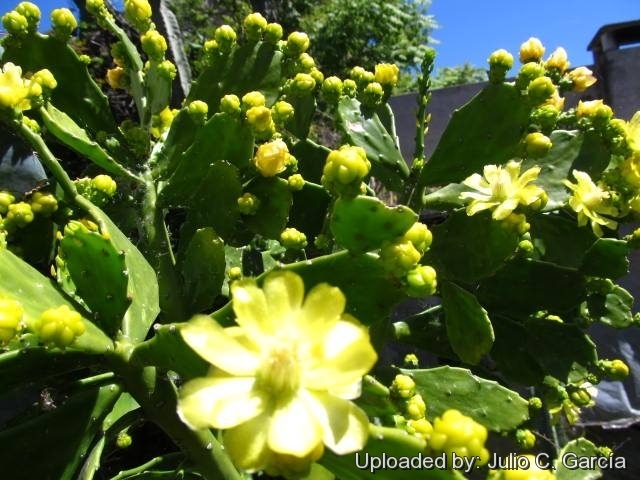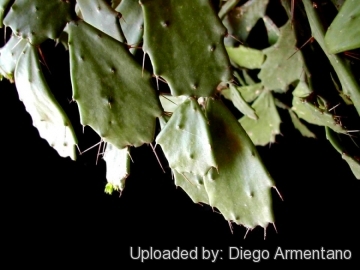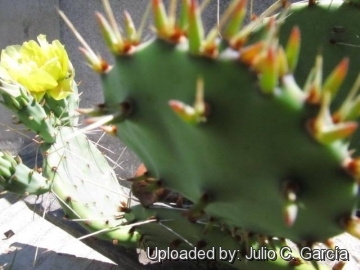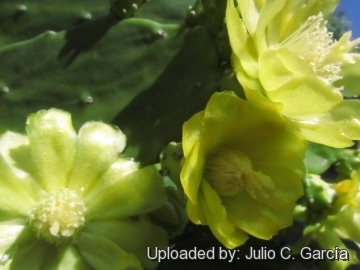Accepted Scientific Name: Brasiliopuntia brasiliensis (Willd.) A.Berger
Entwicklungslin. Kakt. 94. 1926 A.Berger

Cactus brasiliensis (Brasiliopuntia brasiliensis) Photo by: Julio C. García
Origin and Habitat: Opuntia brasiliensisSN|6152]]SN|6152]] is native to South America, from Brazil (western Paraíba, eastern and central-southern Pernambuco, Alagoas, Sergipe, northwestern, northern and eastern Bahia, northeastern and central-southern Minas Gerais and Espírito Santo) in the Atlantic drainage eastwards of the Andes Argentina, Peru, Paraguay and Bolivia (S of Amazon River), becoming naturalized in several places, including Mexico, Honduras, Costa Rica USA: Florida and Puerto Rico.
Altitude range: It occurs at elevations of 0 to 1,000 metres above sea level.
Habitat and Ecology: This cactus occurs in semi-humid forests of extra-Amazonian Brazil in restinga, drier phases of mata atlântica, agreste, caatinga (especially along temporary water courses), mata de brejo, mata seca (on limestone), mata de galeria and mata do planalto, especially on deep sandy substrates and as a lithophyte. Although much of its habitat, especially the Atlantic Forest and agreste, has been destroyed in Brazil due to agricultural expansion, urban expansion, and by quarrying activities and population declines have been recorded, BrasiliSN'> 6150' alt='6152'>Opuntia brasiliensis#SN#6152'>Brasili[[Opuntia brasiliensisSN' style='border:none;'>SN|6150]] is an abundant species, does occur in some national parks and has a very wide range in the southern Neotropics. However, none of these threats is considered to have a major impact.
6150' alt='6152'>Opuntia brasiliensis#SN#6152'>Brasili[[Opuntia brasiliensisSN' style='border:none;'>SN|6150]] is an abundant species, does occur in some national parks and has a very wide range in the southern Neotropics. However, none of these threats is considered to have a major impact.
Synonyms:
See all synonyms of Brasiliopuntia brasiliensis
Common Names include:
ENGLISH: Brazilian Prickley Pear, Brazil brasiliopuntia, Cuija (Bolivia), Tuna (Bolivia), Tunarr (Bolivia)
FRENCH (Français): Brasiliopuntia du Brasil
LITHUANIAN (Lietuvių): Tikroji opuncijėlė
PORTUGUESE (Português): Palmatória, Palmatória-do-diabo, Palmatória-grande, Rumbeba, Urumbeba, Xiquexique-do-sertão, Palmadora, Mumbeca, Mumbebo, Ambeba, Arumbeva, Cumbeba, Facho-de-renda, Gerumbeba, Jurubeba
RUSSIAN (Русский): Бразилиопунция бразильская
SWEDISH (Svenska): Lövopuntia
Description: BrasiliSN'> 6150' alt='6152'>Opuntia brasiliensis#SN#6152'>Brasili[[Opuntia brasiliensisSN' style='border:none;'>SN|6150]] (Opuntia brasiliensisSN|6152]]SN|6152]]) is a tree-like, perennial cactus with a peculiar habit and mode of growth at once distinguish this species. It rises with a perfectly straight erect slender but firm and stiff round trunk to a height to 9 or more metres tall, very gradually tapering to a point furnished all the way up with short mostly horizontal or declining branches bearing bright green branches of flattened, oval, spiny segments. The whole plant resembles a straight taper pole artificially dressed up with branches. The main stem is perfectly round and sheds 2-3-year-old side branches. The pale yellow flowers open in long succession in spring-summer, only on adult plants over 60-100 cm tall, and are followed by small, yellow fruits. A number of species have been described in the past, but are now considered only to be variants of B. brasiliensis.
6150' alt='6152'>Opuntia brasiliensis#SN#6152'>Brasili[[Opuntia brasiliensisSN' style='border:none;'>SN|6150]] (Opuntia brasiliensisSN|6152]]SN|6152]]) is a tree-like, perennial cactus with a peculiar habit and mode of growth at once distinguish this species. It rises with a perfectly straight erect slender but firm and stiff round trunk to a height to 9 or more metres tall, very gradually tapering to a point furnished all the way up with short mostly horizontal or declining branches bearing bright green branches of flattened, oval, spiny segments. The whole plant resembles a straight taper pole artificially dressed up with branches. The main stem is perfectly round and sheds 2-3-year-old side branches. The pale yellow flowers open in long succession in spring-summer, only on adult plants over 60-100 cm tall, and are followed by small, yellow fruits. A number of species have been described in the past, but are now considered only to be variants of B. brasiliensis.
Stem: Trunk, well-formed, woody, cylindric or tapering, slender from the base to the summit, 3 to 9 m tall (occasionally up to 20, or more metres), 20-35 cm in diameter at the base, unjointed; old trunk either naked or covered with fascicles of spines. Branches dimorphic, the lateral ones horizontal, 20-100 cm long more or less verticillate, few to several in each whorl, rounded and terete, that grow shorter toward the summit of the plant; the terminal joints rhomboid to obovate to oblong-lanceolate, irregular in outline, producing thin, flat, leaflike shoots or cladodes to 15 cm long, 6 cm wide, and 4-6 mm thick, bright to dark green, many of these in time dropping off.
Leaves: Small, fleshy, ovoid or subulate, bright green, falling early.
Areoles: With white hairs, producing brown glochids later.
Spines: 1-3, thin, reddish or brownish, to 15 mm long, on young growth, more numerous on the trunk, or lacking.
Flowers: Middle sized, diurmal, borne all over the plant from the prominent parts of the edges of the terminal joints or from the pericarpels of old flowers, shallowly saucer-shaped, bright lemon yellow to light brown, c. 4-6 cm long and wide, petals yellow, oblong, obtuse; filaments very short; staminodial hairs present between perianth parts and stamens.
Fruits: Spherical to pear shaped to oblong, 2.5-4 cm in diameter, yellow, orange-red, red, or purple, with a low or nearly truncate umbilicus, bearing large areoles with distinct clusters of dark brown glochids. The fruit is rather agreeable juicy with a fine acid somewhat resembling an indifferent hard fleshed or unripe Plum with a smell and slight flavour like the leaf stalks of Garden Rhubarb.
Seed: Usually one to five per fruit, very woolly, 6.5-10 mm broadt hick, disklike, laterally compressed.
Chromosome number: 2n = 22
Bibliography: Major references and further lectures
1) James Cullen, Sabina G. Knees, H. Suzanne Cubey “The European Garden Flora Flowering Plants: A Manual for the Identification of Plants Cultivated in Europe, Both Out-of-Doors and Under Glass” Cambridge University Press, 11/Aug/2011
2) David R Hunt; Nigel P Taylor; Graham Charles; International Cactaceae Systematics Group. "The New Cactus Lexicon" dh books, 2006Jackie M. Poole, William R. Carr, Dana
3) E Haustein “Der Kosmos Kakteenfuehrer (the Kosmos Cactus Guide)” Balogh Scientific Books, United States, 01/Dec/1998
4) Lyman David Benson “The Cacti of the United States and Canada” Stanford University Press, 1982
5) N. L. Britton, J. N. Rose: “The Cactaceae. Descriptions and Illustrations of Plants of the Cactus Family.” Vol I, The Carnegie Institution of Washington, Washington 1919
6) Ulises Guzmán, Salvador Arias, Patricia Dávila, “Catálogo de cactáceas mexicanas” Universidad Nacional Autónoma de México, Mexico 2003
7) Urs Eggli, Leonard E. Newton: “Etymological Dictionary of Succulent Plant Names” Birkhäuser 2004
8) Joseph Harrison “The Floricultural Cabinet, and Florists Magazine” Volume 2 Whitaker & Company, 1834
9) Taylor, N.P., Machado, M., Zappi, D., Braun, P., Oakley, L., Pin, A. & Ostalaza, C. 2013. "Brasiliopuntia brasiliensis." The IUCN Red List of Threatened Species. Version 2014.3. <www.iucnredlist.org>. Downloaded on 20 November 2014.
10) M.M. Grandtner, Julien Chevrette “Dictionary of Trees, Volume 2: South America: Nomenclature, Taxonomy and Ecology” Volume 2 Academic Press, 21/Sep/2013
11) Nigel P. Taylor, Daniela C. Zappi “Cacti of Eastern Brazil” Royal Botanic Gardens, Kew, 2004
12) Christopher Brickell “RHS Encyclopedia of Plants and Flowers” Dorling Kindersley Ltd, 01/Sep/2010
13) Curt Backeberg: "Die Cactaceae: Handbuch der Kakteenkunde." 2 Auflage. Band I, Gustav Fischer Verlag, Stuttgart New York 1982
14) Edward Anderson “The Cactus family” Timber Press, Incorporated, 2001
15) Wikipedia contributors. "Brasiliopuntia." Wikipedia, The Free Encyclopedia. Wikipedia, The Free Encyclopedia, 22 Sep. 2014. Web. 21 Nov. 2014.
16) Roberto Kiesling & Omar E. Ferrari, “100 cactus argentinos” Buenos Aires, Editorial Albatros, 2009.
17) Innes C, Wall B “Cacti Succulents and Bromeliads.” Cassell & The Royal Horticultural Society. 1995
18) Taylor, N.P. and Zappi, D.C. “Cacti of Eastern Brazil”. Royal Botanic Gardens, Kew. 2004
19) Taylor, N.P., Machado, M., Zappi, D., Braun, P., Oakley, L., Pin, A. & Ostalaza, C. 2013. Brasiliopuntia brasiliensis. The IUCN Red List of Threatened Species 2013: e.T46517A3007220. http://dx.doi.org/10.2305/IUCN.UK.2013-1.RLTS.T46517A3007220.en. Downloaded on 16 March 2016.
20) Juliana P. Castro, Luiz G.R. Souza, Lânia F. Alves, Ana E.B. Silva, Marcelo Guerra & Leonardo P. Felix. 1073 Marhold (ed.) “IAPT/IOPB chromosome data 15” TAXON 62 (5) • October 2013: 1073–1083
 Cactus brasiliensis (Brasiliopuntia brasiliensis) Photo by: Diego Armentano
Cactus brasiliensis (Brasiliopuntia brasiliensis) Photo by: Diego Armentano Cactus brasiliensis (Brasiliopuntia brasiliensis) Photo by: Julio C. García
Cactus brasiliensis (Brasiliopuntia brasiliensis) Photo by: Julio C. García Cactus brasiliensis (Brasiliopuntia brasiliensis) Photo by: Julio C. García
Cactus brasiliensis (Brasiliopuntia brasiliensis) Photo by: Julio C. García Cactus brasiliensis (Brasiliopuntia brasiliensis) Photo by: Julio C. García
Cactus brasiliensis (Brasiliopuntia brasiliensis) Photo by: Julio C. GarcíaCultivation and Propagation: BrasiliSN'> 6150' alt='6152'>Opuntia brasiliensis#SN#6152'>Brasili[[Opuntia brasiliensisSN' style='border:none;'>SN|6150]] (Opuntia brasiliensisSN|6152]]SN|6152]]) is a a much decorative cactus easily found in cultivation. It is a summer grower species that offers no cultivation difficulties. This cactus can be grown as a tree, and is sometimes grown as an ornamental in gardens, and is occasionally used for hedges.
6150' alt='6152'>Opuntia brasiliensis#SN#6152'>Brasili[[Opuntia brasiliensisSN' style='border:none;'>SN|6150]] (Opuntia brasiliensisSN|6152]]SN|6152]]) is a a much decorative cactus easily found in cultivation. It is a summer grower species that offers no cultivation difficulties. This cactus can be grown as a tree, and is sometimes grown as an ornamental in gardens, and is occasionally used for hedges.
Soil: It will grow in any kind of drained soil, and will resist to droughts, but prefer regular waterings. In pot culture use a draining substratum, as it is sensitive to rottenness when in presence of humidity and low temperatures and let the soil dry out between waterings.
Repotting: Repot in the spring, when their roots become cramped. Generally, they should be repotted every other year in order to provide fresh soil. After repotting, do not water for a week or more.
Water: In summer, during the vegetative period, it must be regularly watered, but allowing the substratum to completely dry up before irrigating again (but do not overwater ); in winter, it’s to be kept dry. Preferable not to water on overcast days, humid days or cold winter days.
Hardiness: It is not very frost resistant cactus, hardy to -2° C or less if very dry. However in cultivation it is better not to expose it to temperatures lower than 10° C, even if in an aerated and protected location, in order to avoid the formation of anti-aesthetic spots on the epidermis. In presence of high atmospheric humidity avoid any frost as it is particularly sensitive to root rot. It can handle extremely high temperatures in summer.
Exposure: Outside full sun or afternoon shade (but adapt to shade too), inside needs bright light, and some direct sun.
Use: It is suitable for “desert” gardens, in association with other xerophytes. Where the open air cultivation is not possible due to the climate, it is to be cultivated in pot in order to shelter it in winter. The fruits are edible. Fruits and cladodes are used in folk medicine. Its also an important edge plant and the cladodes are used for forage and fodder, and wood has been used in making furniture.
Warning: It is armed with treacherous spines that are extremely sharp (This is one of the most dangerous of all cactus). Handle it with extreme caution, and keep it away from gangways and areas frequented by children and animals. Spines must be meticulously removed with tweezers.
Propagation: Can be propagated by cuttings and seeds (these need to be fermented, to simulate the digestive tract of the natural dispersors). Prickly pear pads root easily and grow rapidly when placed in loose, well-draining soil.















